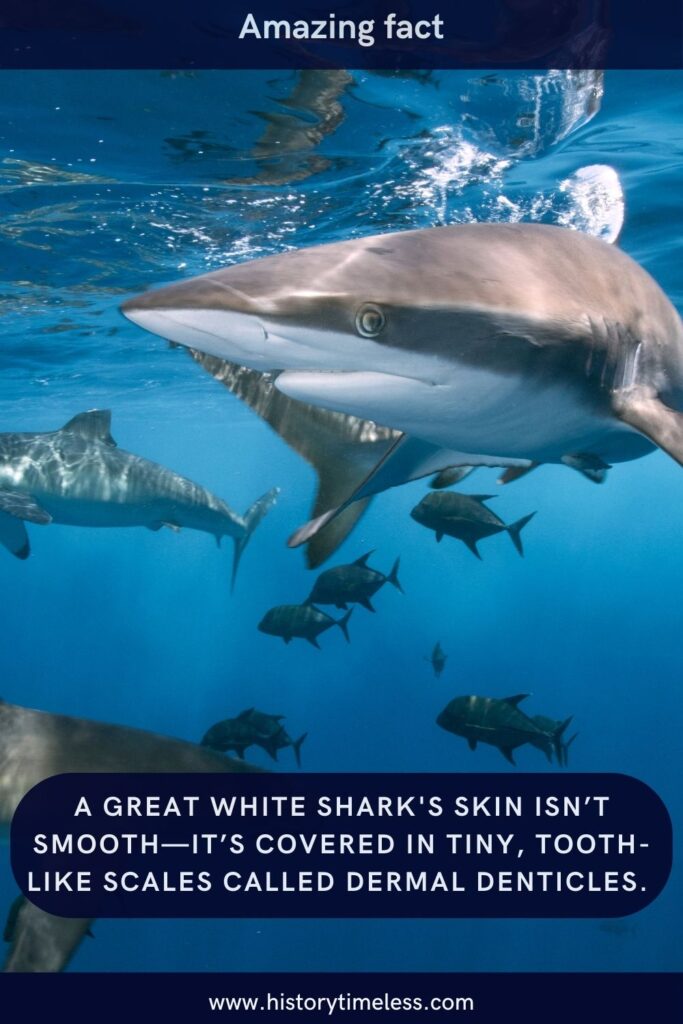Great white sharks are among the ocean’s most iconic predators, striking both fear and fascination in people across the globe. Known for their powerful presence and sharp teeth, these creatures play a vital role in maintaining the balance of marine ecosystems.
But beyond the popular image painted by Hollywood, great white sharks have plenty of surprising, lesser-known qualities. From their mysterious migration patterns to their impressive sensory skills, these apex predators are full of secrets.
Let’s dive into some jaw-dropping facts that might just change the way you see these legendary ocean dwellers.
1. Great Whites Can Detect a Drop of Blood from Miles Away
Great white sharks have an extraordinary sense of smell that allows them to detect a single drop of blood in 25 gallons (100 liters) of water. They can even smell blood from up to three miles away, depending on the conditions.

This powerful sense plays a crucial role in locating wounded prey across vast stretches of ocean. Their nostrils, located on the underside of their snout, are not used for breathing but solely for smelling, making them some of the most efficient hunters in the marine world.
2. They Use Electroreception to Hunt Prey
In addition to a keen sense of smell, great white sharks possess a sixth sense called electroreception. Special pores around their snout—called ampullae of Lorenzini—allow them to detect the tiny electrical signals emitted by the muscles and hearts of other animals.
This helps them locate prey even in murky waters or when it’s buried beneath sand. It’s like having a built-in metal detector, but for life itself—especially useful when stalking stealthy prey like rays or flatfish.
3. Great Whites Can Launch Themselves Out of Water
One of the most jaw-dropping behaviors of great white sharks is their ability to breach—completely launching themselves out of the water. This dramatic move is most commonly seen in South Africa when hunting seals.
By speeding upward from deep below at over 25 mph (40 km/h), they strike with such force that their entire body can leave the water. It’s both a powerful hunting tactic and an awe-inspiring spectacle of nature’s raw strength.
4. Their Teeth Constantly Regrow Throughout Life
Great white sharks don’t worry about losing teeth—because they have replacements constantly on standby. In fact, a great white shark can go through over 20,000 teeth in its lifetime.
Their teeth are arranged in rows, and when one falls out, another rotates forward to take its place like a conveyor belt.
This ensures their deadly bite is always sharp, efficient, and ready for the next meal. It’s one of the reasons they remain such effective predators.
5. They Can Live for Over 70 Years
While their mysterious lifestyles have made age estimates tricky, recent research shows that great white sharks can live up to 70 years or more. This makes them one of the longest-living cartilaginous fish species on the planet.
Their long lifespan also means they grow slowly and reproduce later in life, which contributes to their vulnerability when populations are impacted by human activity, such as overfishing or bycatch.
6. Baby Great Whites Are Born Fully Equipped to Hunt
Unlike many fish, great white sharks give birth to live young that are already miniature predators. Called “pups,” these baby sharks are typically around 4–5 feet (1.2–1.5 meters) long at birth.
Even more fascinating, they are born with a full set of sharp teeth and instinctively swim away to fend for themselves—because in the shark world, even mom might see you as food. It’s survival of the fittest from the very beginning.
7. They’re Surprisingly Curious and Intelligent Hunters
Although feared for their aggression, great white sharks are also curious and surprisingly intelligent creatures. They often “test bite” unfamiliar objects, not out of rage but as a form of exploration.
These sharks use problem-solving skills and memory to identify prey and navigate their environments. In some studies, they’ve even demonstrated individual personality traits, suggesting there’s much more going on behind those cold, dark eyes than we once thought.
8. Great Whites Can Regulate Their Body Temperature
Unlike most fish, great white sharks are partially warm-blooded. They can regulate their internal body temperature to stay warmer than the surrounding water—a trait called regional endothermy.
This ability allows them to move quickly, hunt efficiently, and thrive in cooler waters where other sharks might struggle.
Their unique vascular system conserves heat generated by their muscles, giving them a serious edge in colder hunting grounds like the coasts of California or South Africa.
9. They Migrate Thousands of Miles Across Oceans
Great white sharks are long-distance travelers. Some have been tracked migrating over 12,000 miles in a single journey. They move between feeding and breeding grounds, sometimes disappearing for months before resurfacing in familiar spots.
One famous shark, nicknamed “Nicole,” was tracked from South Africa to Australia and back again—a round trip of over 13,000 miles. These migrations are still not fully understood, making them one of the ocean’s most mysterious wanderers.
10. Great Whites Rarely Attack Humans Intentionally
Despite their fearsome reputation, great white shark attacks on humans are extremely rare—and often a case of mistaken identity. Surfers and swimmers can resemble seals from below, leading to an investigative bite.
However, once they realize the “prey” isn’t what they expected, they usually swim away. Most bites are not fatal, and great whites don’t consider humans part of their diet. In fact, more people are injured each year by toasters than by sharks!
11. Great White Sharks Have No Natural Predators—Except One
As apex predators, adult great white sharks have virtually no natural enemies in the ocean—except for one surprising contender: the orca, or killer whale. Orcas have been observed preying on great whites, often targeting their nutrient-rich livers.
In areas where orcas are active, great whites have been known to flee and abandon hunting grounds for months. It’s a rare but real example of predator vs. predator at the top of the food chain.
12. Their Skin Is Tougher Than Sandpaper
A great white shark’s skin isn’t smooth—it’s covered in tiny, tooth-like scales called dermal denticles. These structures reduce drag and help them glide silently through the water.

But they also make the skin feel like rough sandpaper. In fact, ancient sailors used shark skin as a type of natural sandpaper. This unique skin not only improves hydrodynamics but also protects the shark from injuries and parasites.
13. They Can Swim at Incredible Speeds
Great white sharks are built for bursts of speed. With powerful tails and streamlined bodies, they can reach speeds of up to 25 miles per hour (40 km/h).
This speed allows them to ambush prey with incredible force, especially during breaching attacks. Their acceleration is one of their deadliest advantages, catching seals and fish completely off guard. It’s a perfect blend of power and precision.
14. Their Eyes Can Roll Back During Attacks
When going in for a bite, a great white shark’s eyes roll back into its head. This protects their sensitive eyeballs from potential injury as they thrash into struggling prey.
It’s like nature’s built-in safety goggles. Some species of sharks use a special membrane for the same purpose, but great whites rely on this eye-rolling action to keep their vision safe while delivering a crushing bite.
15. They Can Go Weeks Without Eating
Despite their fearsome reputation as constant hunters, great white sharks can go days or even weeks without a meal after a big catch.
Thanks to their large, fatty livers and slow digestion, they store energy efficiently. A single large prey item like a seal can sustain them for a long time.
This energy conservation allows them to go on long migrations without frequent feeding stops—perfect for life on the move.
16. Great Whites Use “Sneak and Strike” Hunting Strategy
Rather than charging straight at their prey, great white sharks often employ a stealthy approach from below or behind, using the element of surprise. This “sneak and strike” method involves slowly circling, then rocketing upward at high speed for a devastating first bite.
The shark may then wait and let the wounded prey weaken before returning to finish the job. It’s a methodical and highly effective strategy, showcasing their calculated predatory skills.
17. Their Jaws Are Not Attached Like Ours
A great white shark’s jaw isn’t fused to its skull—it’s loosely attached and can extend outward. This means when they bite, their jaws literally shoot forward, allowing them to take larger chunks out of their prey.
Combined with serrated teeth and tremendous bite force, this feature makes their attack even more destructive. It’s one of the reasons they can bite through thick hides and even boat materials when curious.
18. They Play a Vital Role in Ocean Health
Far from being villains, great white sharks are essential to the balance of marine ecosystems. As apex predators, they keep populations of seals, sea lions, and large fish in check, which in turn maintains the health of coral reefs and seagrass beds.
Without them, ecosystems could spiral into imbalance. Their presence signals a healthy ocean, and their protection helps preserve the natural order of the sea.
19. Their Bite Force Is Among the Strongest of Any Shark
While they don’t have the absolute strongest bite in the animal kingdom, great white sharks still boast a bite force of up to 4,000 PSI (pounds per square inch).
That’s strong enough to bite through bone, turtle shells, and even small boats. Their serrated teeth work like steak knives, sawing through flesh with each shake of the head. It’s a jaw-dropping combination of strength and cutting power.
20. They’re Protected in Many Parts of the World
Due to declining populations from overfishing and fear-driven killing, great white sharks are now protected by law in several countries, including the United States, Australia, and South Africa. It’s illegal to catch or harass them in these regions.
Conservationists are also using satellite tags and tracking devices to learn more about their migration and behavior. These efforts aim to preserve not just the species, but the health of entire ocean ecosystems.
21. Great Whites Prefer Coastal Waters with Rich Prey
Great white sharks are most commonly found in temperate coastal waters, where seal and fish populations are abundant. These regions offer ideal feeding grounds, particularly near places like South Africa’s Seal Island, California’s Farallon Islands, and Australia’s Neptune Islands.
While they can dive into deep waters, they often stay near the coast—where food is plentiful and hunting opportunities are frequent. So if you’re ever wondering why shark sightings spike in some areas, it’s probably a buffet beneath the surface.
22. They Rarely Survive in Captivity
Unlike many other marine animals, great white sharks do not thrive in captivity. Aquariums have tried to house them, but most individuals survive only days or weeks before dying or being released. The likely reasons include stress, refusal to eat, and injury from constantly swimming into tank walls.
Their need for vast open waters and natural hunting conditions makes them ill-suited for confinement. That’s why you won’t find them on display, and it’s part of what makes encounters in the wild so unique.
23. Great White Shark Pups Eat Each Other Before Birth
Here’s a brutal but fascinating fact: inside the womb, great white shark embryos engage in intrauterine cannibalism. The strongest pups eat their weaker siblings before birth, ensuring only the fittest are born.
This behavior, called oophagy, gives surviving pups a head start in strength and survival skills. It might sound ruthless, but in the competitive world of sharks, it’s nature’s way of preparing them for life as apex predators from the very start.
24. Each Great White Has a Unique “Face”
Believe it or not, researchers have discovered that individual great white sharks can be identified by their unique markings and scars—particularly around their gills, fins, and nose.
Much like fingerprints in humans, these subtle patterns help scientists track and study specific sharks over time. Some sharks become so recognizable they’re given names and followed for years, helping to uncover insights about migration, lifespan, and behavior.
25. Climate Change May Be Shifting Their Range
As ocean temperatures rise due to climate change, great white sharks are expanding into new territories. Sightings have increased in previously cooler waters, including parts of the northeastern United States and the UK.
Warmer seas can change prey availability, breeding zones, and migration timing. Scientists are closely monitoring these changes, as shifts in shark populations could impact local marine ecosystems and coastal human activity. Great whites, it seems, are not immune to the ripple effects of a warming planet.
Discover more interesting facts:
30 Dark Tales Where Fate Takes a Shocking Turn!
20+ Bizarre Medical Mysteries That’ll Leave You Speechless!
25 Shocking Secrets of Ancient Rome You Never Knew!
10+ Amazing Zodiac Facts About Libra Women





